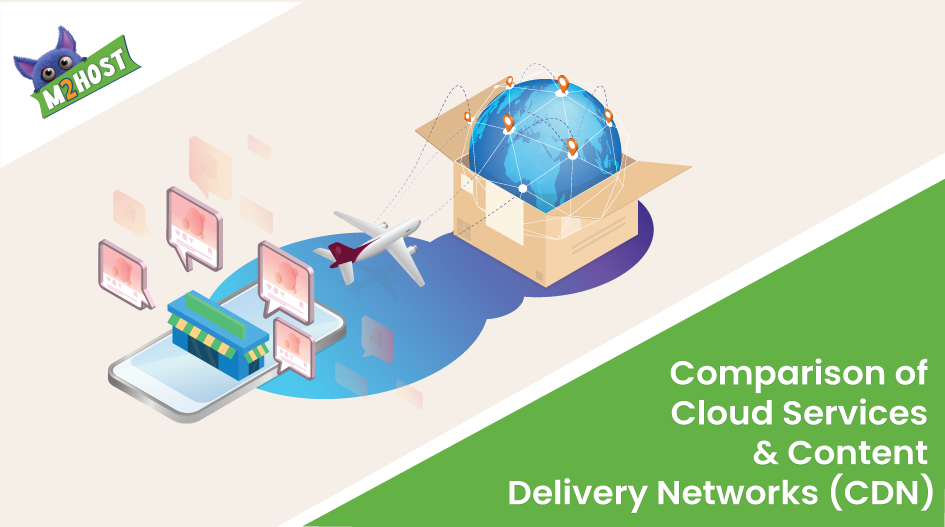The internet of data is expanding at an astonishing rate, and its size will increase exponentially within the next few years. Customers anticipate having instant and risk-free internet connectivity on any platform and from anywhere in the world. Information suppliers must devise a remedy to the problems that arise when attempting to distribute and organize material for consumption on PCs, mobiles, and touchscreens. More functionality, greater adaptability, high standards of products, and better levels of safety are all examples of some of the most common problems encountered in this scenario. Cloud hosting and CDN are two commonly used techniques that can be utilized to address these challenges.
What is a CDN?
A CDN is a system that is distributed and consists of memory and host equipment. This platform can recreate material or apps such as data, sound, and clips, among other things, on a great number of substitute devices that are placed in a wide range of physical regions all over the world. They are highly adaptable and increase the accessibility as well as the level of the operations that are available on the internet. They do this by lowering the amount of time it takes to send information to their customers. The CDNs achieve this by intentionally distributing material copies in places that are widely separated to maximize the capacity that is used by users across the internet to transfer data.
In this rapidly evolving environment that is the web in the world today, it is more necessary than it has ever been for information companies to have a solid understanding of the wants and necessities of customers. Take, as an illustration, a company that streams video clips, such as Netflix or YouTube. The visual quality that is provided to members who are situated in different regions can change during the distribution of multimedia materials and is dependent on the service platform that is used to reach the end consumer. It is the solution to this problem.

What is the purpose of CDN?
They might differ from one another based on the type of content and purpose. On the other hand, the majority of content delivery networks. It consists of a source site, a demand-routing system, and many substitute storage service customers as points of presence (POP).
Source Site
It is an effective memory solution that holds all the information in its database. The data stored on the source site is replicated onto substitute sites that are situated in various regions across the world.
Point of Presence Servers
These systems are dispersed over a CDN in vast quantities and various locations. When the middle demands the data, the POP client uses it for them. If the materials are not on a regional website, the POP service will fetch them from the site where they were originally stored and save them for the occasion when they needed again.
A Request-Based Mechanism for Redirecting Requests
One of the primary responsibilities of a CDN is to reroute users to the systems that provide the highest quality of service (QoS), taking into account factors such as loading speed, network problems, delay, and other variables. This approach can be implemented through the use of a wide number of techniques, including Global Server Load Balancing (GSLB), DNS-based request-routing, HTTP Redirection, and URL Reworking.
The Benefits of Using CDNs
They are used by online businesses such as game publishers, e-commerce platforms, internet app developers, and webcasting video services to improve the quality of the products that they provide to their customers.
A few advantages of CDN are as follows:
Additional Capacity for Flexibility and Internet Access
A quick loading speed is one of the ways that CDN claims to improve the user interface. In addition, they provide site companies with greater webpage visits, decreased rates of site invalidation, extra traffic, and an improved overall level of consumer involvement.
Reduced Usage of Available Bandwidth
The operators of internet companies have assessed a fee for any information that is transmitted from the site where it originated. Because CDN keeps versions of online content in a geographical area that is nearer to its end customers, it assures that little information is sent from the systems of the source. The total costs of companies are brought down quite a bit.
Reduce the Time Lag
Ultimately, customers can demand the system to transmit the knowledge whenever they want to. The actual distance that exists between facilities and end customers is one factor that might contribute to delays. Most latency-related problems are handled because of the fact that CDNs provide content from servers situated nearby.
Implementation of Traffic Congestion Rises
Visuals that go viral, effective advertising efforts, or restricted deals can all be the causes of an abrupt and unanticipated increase in the need for goods. By distributing the workload among internet sites located in a wide variety of localities, CDNs can avoid these types of system breakdowns.
What exactly does the abbreviation “Cloud Service” stand for?
The structure of larger networks of virtual server features and procedures, such as equipment recourses, database queries, and application web servers, is referred to as a “cloud service,” and the phrase “cloud provider” refers to this composition. They are also referred to using this name. Through the exploitation of computing, the traditional data facility has been transformed into an online storage system that is more flexible.
Virtualization techniques such as processor systems and the development of virtual servers have made it possible for companies to improve the availability of sponsored webpages or apps to share information more efficiently with end customers. With the assistance of cloud services, information systems can offer more adaptable web program services, including hosting, search, internet hosting, and entertainment, in a manner that is both more cost-effective and less expensive.
There are several other names for cloud services, including IaaS, PaaS, and SaaS. Host companies are accountable for the management and upkeep of the massive data centers, sometimes known as “fields,” which are the physical locations of web apps.

A summary of significant characteristics of internet technologies is provided below:
- Operation at your rate and on request
- Accessibility to a wide range of network
- The sharing of materials
- Scalability
- Provider with moderation
Technology as a platform in the cloud gives users access to a practically endless number of memory and data processing possibilities, which they may use to analyze and maintain data. Rather than engaging in more facilities, they can use internet assets on an as-needed basis and under pay-per-use pricing structures.
How does the service in the cloud work?
They can be broken down into three categories based on the functions they perform:
Private cloud
It refers to a cloud computing environment that is only accessible to a particular company or organization. It can be linked to basic parts that are kept either on the site or in the network infrastructure of a business supplier. Because it can only be used by one company at a time, this approach gives its customers a great deal of influence over the situation. It offers enhanced privacy procedures, a customizable architecture, and the ability to augment computing capacity in a virtual machine whenever it is required to do so.
Public cloud
It is a storage and management platform that uses the web to facilitate information and resource management. It is a completely integrated platform, which makes it possible to tap into common capabilities on demand. Because all the tools are made available over the internet, this strategy makes it simple for businesses to expand their operations.
Hybrid Cloud
This type of cloud computing is a hybrid, which means that it combines elements of both private and public cloud systems. Here, businesses have the opportunity to take advantage of resource sharing while continuing to make use of the information technology equipment they already own. They are also permitted to store sensitive client data on their servers and to obtain that content using programs that are hosted in the public cloud.
The Advantages of Using Cloud Services
They are quickly becoming increasingly popular due to the many advantages they offer. This concept is more expensive than installing servers locally, but it also has the potential to deliver quicker and better service to clients.
Aside from the abovementioned factors, companies that utilize cloud storage have more scalability alternatives. It can accommodate the businesses’ ever-evolving requirements and ongoing developments in the present. This approach has to be more dependable and effective in providing data backup and restoration during times of emergency. For companies who utilize cloud services, it makes sense to keep expensive system assets in their operations.
Comparison of Content Delivery Networks and Cloud Services:
Parallels and Deviations
They are comparable since the material in both situations is supplied from systems located in various locations. On the other hand, internet services depend on their adaptability, mobility, and supply of information and applications. It provides the content to affected customers as quickly as feasible, while internet services rely on these characteristics.
Utilization of CDN in Association with Cloud Services
The discussion that was just above made two things quite clear. A web host makes it possible for a system’s abilities to expand easily, and a CDN provides a framework that may provide a significant amount of data closer to the client. It would be great if we could combine both of these models into one, but is it even possible? Offering and maintaining multi-tiered platforms that can expand in response to the requirements of the client can be accomplished at a lower cost by utilizing cloud computing solutions in connection with a CDN. The radical change that is required in order to move from traditional CDNs that are server-based or customer-based to one that is cloud-based is a substantial one that brings in a number of critical perks as well as challenges.
The following is a list of some of the primary benefits that are associated with using a CCDN model:
Charge
It is more costly than having the customers themselves possess the infrastructure that is necessary for them to be a part of the CDN.
A significantly increased level of point of presence
Due to the availability of cloud services, the information is relocated faster to the consumers than it would be under the conventional CDN structure.
CCDN Compatibility
Compatibility between CDNs will help content creators to expand their presence into new locations and industries.
Help and Assistance with Applications
It can accommodate radical shifts, which makes it easier for CDNs to handle a variety of programs, including those with unexpected and regular exploding demands.
Conclusion
This article discusses the benefits and drawbacks of CDNs as well as cloud computing. The networks have grown more as a way of maximizing the benefits afforded by both of these alternatives. The combination of CDNs and cloud services produces financial impacts that make it possible for the content to be distributed to end users in a way that is both practical and inexpensive.



